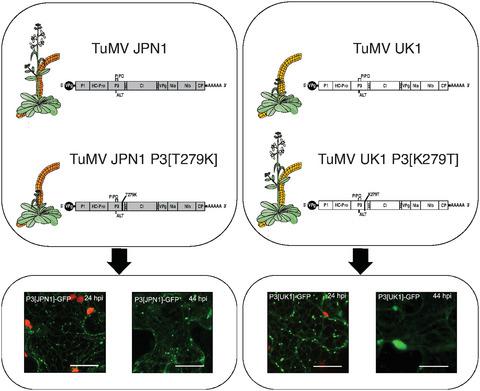当前位置:
X-MOL 学术
›
Mol. Plant Pathol.
›
论文详情
Our official English website, www.x-mol.net, welcomes your
feedback! (Note: you will need to create a separate account there.)
Association between flower stalk elongation, an Arabidopsis developmental trait, and the subcellular location and movement dynamics of the nonstructural protein P3 of Turnip mosaic virus.
Molecular Plant Pathology ( IF 4.8 ) Pub Date : 2020-08-01 , DOI: 10.1111/mpp.12976 Silvia López-González 1 , José Antonio Navarro 2 , Luis F Pacios 1 , Papaiah Sardaru 1 , Vicente Pallás 2 , Flora Sánchez 1 , Fernando Ponz 1
Molecular Plant Pathology ( IF 4.8 ) Pub Date : 2020-08-01 , DOI: 10.1111/mpp.12976 Silvia López-González 1 , José Antonio Navarro 2 , Luis F Pacios 1 , Papaiah Sardaru 1 , Vicente Pallás 2 , Flora Sánchez 1 , Fernando Ponz 1
Affiliation

|
Virus infections affect plant developmental traits but this aspect of the interaction has not been extensively studied so far. Two strains of Turnip mosaic virus differentially affect Arabidopsis development, especially flower stalk elongation, which allowed phenotypical, cellular, and molecular characterization of the viral determinant, the P3 protein. Transiently expressed wild‐type green fluorescent protein‐tagged P3 proteins of both strains and selected mutants of them revealed important differences in their behaviour as endoplasmic reticulum (ER)‐associated peripheral proteins flowing along the reticulum, forming punctate accumulations. Three‐dimensional (3D) model structures of all expressed P3 proteins were computationally constructed through I‐TASSER protein structure predictions, which were used to compute protein surfaces and map electrostatic potentials to characterize the effect of amino acid changes on features related to protein interactions and to phenotypical and subcellular results. The amino acid at position 279 was the main determinant affecting stalk development. It also determined the speed of ER‐flow of the expressed proteins and their final location. A marked change in the protein surface electrostatic potential correlated with changes in subcellular location. One single amino acid in the P3 viral protein determines all the analysed differential characteristics between strains differentially affecting flower stalk development. A model proposing a role of the protein in the intracellular movement of the viral replication complex, in association with the viral 6K2 protein, is proposed. The type of association between both viral proteins could differ between the strains.
中文翻译:

花茎伸长,拟南芥发育性状与芜菁花叶病毒非结构蛋白P3的亚细胞定位和运动动力学之间的关联。
病毒感染影响植物的发育性状,但到目前为止,尚未广泛研究这种相互作用的方面。两株芜菁花叶病毒差异影响拟南芥发育,特别是花梗的延长,可以对病毒决定簇P3蛋白进行表型,细胞和分子表征。这两个菌株及其选定突变体的瞬时表达的带有野生型绿色荧光蛋白标签的P3蛋白均显示出其行为的重要差异,因为内质网(ER)相关的周围蛋白沿网状结构流动,形成点状积累。所有表达的P3蛋白质的三维(3D)模型结构都是通过I-TASSER蛋白质结构预测构建的,用于计算蛋白质表面并绘制静电势,以表征氨基酸变化对与蛋白质相互作用和表型和亚细胞的结果。279位氨基酸是影响茎发育的主要决定因素。它还确定了表达蛋白的ER流动速度及其最终位置。蛋白质表面静电势的显着变化与亚细胞位置的变化相关。P3病毒蛋白中的一个氨基酸决定了差异影响花梗发育的菌株之间所有已分析的差异特征。提出了一个模型,该模型与病毒6K2蛋白相关,提出了该蛋白在病毒复制复合物的胞内运动中的作用。两种病毒蛋白之间的结合类型在菌株之间可能不同。蛋白质表面静电势的显着变化与亚细胞位置的变化相关。P3病毒蛋白中的一个氨基酸决定了差异影响花梗发育的菌株之间所有已分析的差异特征。提出了一个模型,该模型与病毒6K2蛋白相关,提出了该蛋白在病毒复制复合物的胞内运动中的作用。两种病毒蛋白之间的结合类型在菌株之间可能不同。蛋白质表面静电势的显着变化与亚细胞位置的变化相关。P3病毒蛋白中的一个氨基酸决定了差异影响花梗发育的菌株之间所有已分析的差异特征。提出了一个模型,该模型与病毒6K2蛋白相关,提出了该蛋白在病毒复制复合物的胞内运动中的作用。两种病毒蛋白之间的结合类型在菌株之间可能不同。提出了一个模型,该模型与病毒6K2蛋白相关,提出了该蛋白在病毒复制复合物的胞内运动中的作用。两种病毒蛋白之间的结合类型在菌株之间可能不同。提出了一个模型,该模型与病毒6K2蛋白相关,提出了该蛋白在病毒复制复合物的胞内运动中的作用。两种病毒蛋白之间的结合类型在菌株之间可能不同。
更新日期:2020-08-01
中文翻译:

花茎伸长,拟南芥发育性状与芜菁花叶病毒非结构蛋白P3的亚细胞定位和运动动力学之间的关联。
病毒感染影响植物的发育性状,但到目前为止,尚未广泛研究这种相互作用的方面。两株芜菁花叶病毒差异影响拟南芥发育,特别是花梗的延长,可以对病毒决定簇P3蛋白进行表型,细胞和分子表征。这两个菌株及其选定突变体的瞬时表达的带有野生型绿色荧光蛋白标签的P3蛋白均显示出其行为的重要差异,因为内质网(ER)相关的周围蛋白沿网状结构流动,形成点状积累。所有表达的P3蛋白质的三维(3D)模型结构都是通过I-TASSER蛋白质结构预测构建的,用于计算蛋白质表面并绘制静电势,以表征氨基酸变化对与蛋白质相互作用和表型和亚细胞的结果。279位氨基酸是影响茎发育的主要决定因素。它还确定了表达蛋白的ER流动速度及其最终位置。蛋白质表面静电势的显着变化与亚细胞位置的变化相关。P3病毒蛋白中的一个氨基酸决定了差异影响花梗发育的菌株之间所有已分析的差异特征。提出了一个模型,该模型与病毒6K2蛋白相关,提出了该蛋白在病毒复制复合物的胞内运动中的作用。两种病毒蛋白之间的结合类型在菌株之间可能不同。蛋白质表面静电势的显着变化与亚细胞位置的变化相关。P3病毒蛋白中的一个氨基酸决定了差异影响花梗发育的菌株之间所有已分析的差异特征。提出了一个模型,该模型与病毒6K2蛋白相关,提出了该蛋白在病毒复制复合物的胞内运动中的作用。两种病毒蛋白之间的结合类型在菌株之间可能不同。蛋白质表面静电势的显着变化与亚细胞位置的变化相关。P3病毒蛋白中的一个氨基酸决定了差异影响花梗发育的菌株之间所有已分析的差异特征。提出了一个模型,该模型与病毒6K2蛋白相关,提出了该蛋白在病毒复制复合物的胞内运动中的作用。两种病毒蛋白之间的结合类型在菌株之间可能不同。提出了一个模型,该模型与病毒6K2蛋白相关,提出了该蛋白在病毒复制复合物的胞内运动中的作用。两种病毒蛋白之间的结合类型在菌株之间可能不同。提出了一个模型,该模型与病毒6K2蛋白相关,提出了该蛋白在病毒复制复合物的胞内运动中的作用。两种病毒蛋白之间的结合类型在菌株之间可能不同。











































 京公网安备 11010802027423号
京公网安备 11010802027423号